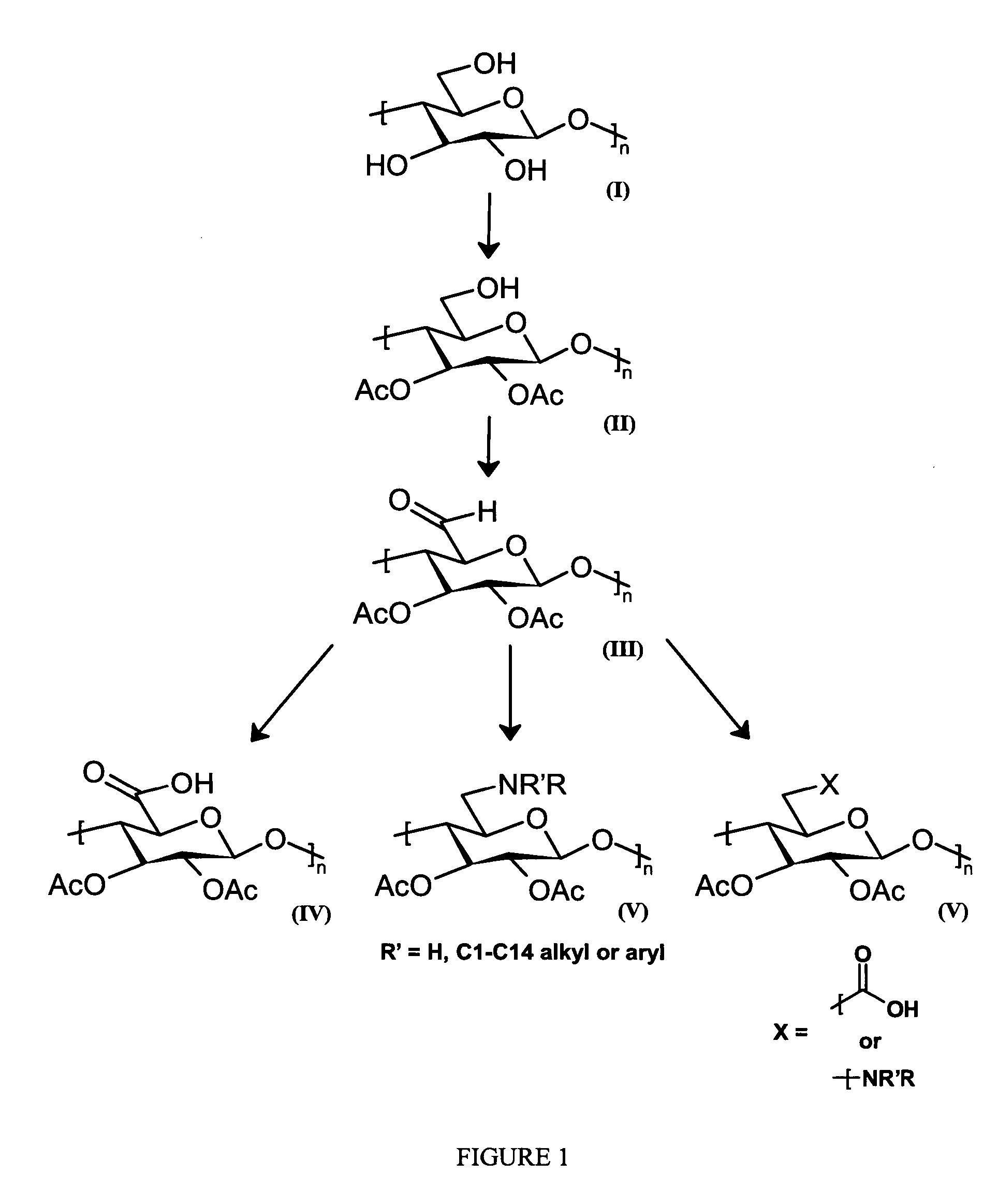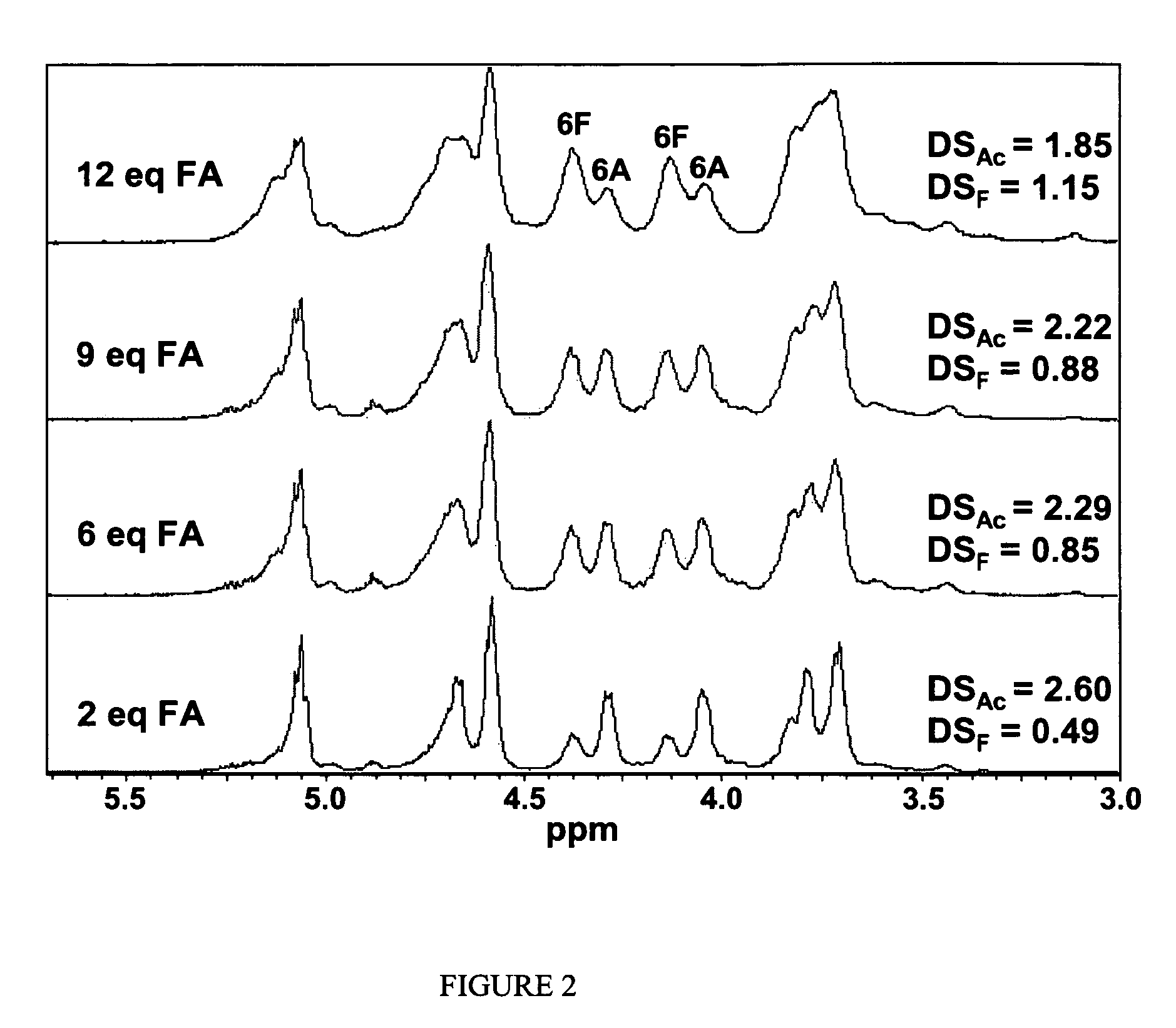Cellulose interpolymers and method of oxidation
a technology of cellulose interpolymer and cellulose ester, which is applied in the direction of sugar derivates, organic chemistry, coatings, etc., can solve the problems of mixed cellulose formate derivative formation that has received little attention, and the method of preparation is not easy to achiev
- Summary
- Abstract
- Description
- Claims
- Application Information
AI Technical Summary
Benefits of technology
Problems solved by technology
Method used
Image
Examples
examples 1-5
[0207]To a 5 L 5-neck round-bottom jacked-flask equipped with a mechanical stirrer, reflux condenser, thermocouple, addition funnel, and a temperature controlled circulating bath was added a solution of 88% formic acid (See Table 1). The solution was chilled to 5° C. before adding 318 mL of Ac2O over a 20 min period. To this solution, was added 125 g of cellulose followed by a solution of 9.35 g of H2SO4 in 55 mL of acetic acid. Following the addition of the H2SO4, the flask temperature was adjusted to 15° C. The heterogeneous mixture was stirred at this temperature for 70 min before adding an amount of Ac2O slowly (See Table 1) (3.2 h addition). During the Ac2O addition, the internal reaction temperature reached 37° C. Following completion of the Ac2O addition, the reaction temperature was increased to 58° C. The reaction mixture became a homogeneous solution 6.8 h after adding the cellulose. The reaction temperature was maintained at 58° C. for an additional 4 h after the homogene...
examples 6-8
[0210]To a 1 L 3-neck round-bottom flask equipped with a mechanical stirrer, reflux condenser, and addition funnel was added 100 mL of 88% formic acid (15 molar equivalents based on cellulose). The solution was chilled to 0° C. before adding 65 mL of Ac2O over a 10 min period. After warming to ambient temperature, 25 g of cellulose was added to the solution followed by a solution of 1.88 g of H2SO4 in 15 mL of acetic acid. The heterogeneous mixture was stirred for 30 min before the flask temperature was placed in a 30° C. water bath. To the heterogeneous mixture was added 172 mL of Ac2O (9 molar equivalents based on cellulose, 20 min addition). Following completion of the Ac2O addition, the reaction mixture was stirred for 10 min before the reaction temperature was increased to 50° C. The reaction mixture became a homogeneous solution 1.7 h after adding the cellulose. The reaction temperature was maintained at 50° C. and aliquots were removed at different time intervals. Each sample...
example 9
[0215]To a 5 L 5-neck round-bottom jacked-flask equipped with a mechanical stirrer, reflux condenser, thermocouple, addition funnel, and a temperature controlled circulating bath was added 500 mL of 88% formic acid (15 molar equivalents based on cellulose). The solution was chilled to 4° C. before adding 430 mL of Pr2O over a 20 min period. The solution was warmed to 20° C. before adding 125 g of water-activated cellulose. To the heterogeneous mixture was added a solution of 9.35 g of H2SO4 in 80.5 mL of propionic acid. Following the addition of the H2SO4, the flask temperature was adjusted to 30° C. before adding 885 mL of Pr2O slowly (9 molar equivalents based on cellulose, 30 min addition). During the Pr2O addition, the maximum internal reaction temperature reached was 37° C. The reaction mixture became a homogeneous solution 55 min after adding the cellulose. The reaction temperature was increased to 50° C. and homogeneous solution was held at this temperature for an additional ...
PUM
| Property | Measurement | Unit |
|---|---|---|
| temperature | aaaaa | aaaaa |
| pH | aaaaa | aaaaa |
| pH | aaaaa | aaaaa |
Abstract
Description
Claims
Application Information
 Login to View More
Login to View More - R&D
- Intellectual Property
- Life Sciences
- Materials
- Tech Scout
- Unparalleled Data Quality
- Higher Quality Content
- 60% Fewer Hallucinations
Browse by: Latest US Patents, China's latest patents, Technical Efficacy Thesaurus, Application Domain, Technology Topic, Popular Technical Reports.
© 2025 PatSnap. All rights reserved.Legal|Privacy policy|Modern Slavery Act Transparency Statement|Sitemap|About US| Contact US: help@patsnap.com



